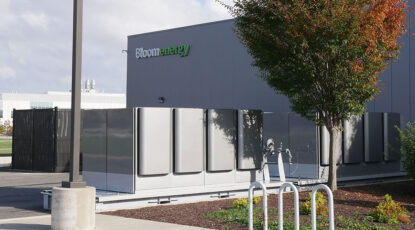As the world moves toward carbon-neutral energy, hydrogen is emerging as a solid solution in the alternative energy landscape. Hydrogen fuel cells are at the center of this transformation, with Bloom Energy’s solid oxide fuel cell (SOFC) technology guiding the way.
In a recent podcast episode of Engineering.com’s “The Primary Loop,” Carl Cottuli, Head of Development Engineering at Bloom, shared insights into how hydrogen fuel cells are paving the way for the clean energy revolution.
What is the Hydrogen Economy?
The hydrogen economy refers to a vision of a future energy system that relies on hydrogen as a key energy source to decarbonize industries. Hydrogen is a clean fuel that produces electricity, with only water vapor as a byproduct when used in fuel cells. This positions hydrogen as a powerful solution for reducing carbon emissions and advancing decarbonization goals across sectors like transportation, power generation, and industrial applications.
How Do Hydrogen Fuel Cells Work?
At the core of the hydrogen economy is hydrogen fuel cell technology, which converts hydrogen into electricity through an electrochemical reaction. During the podcast, Cottuli explains that Bloom’s SOFCs flow hydrogen and oxygen across opposite surfaces, generating electricity and water in the process. This innovative technology scales up from small systems to multi-megawatt applications, making it a flexible solution for various industries—from industrial facilities to home-based energy systems.
By utilizing green hydrogen generated from renewable energy sources, Bloom’s SOFC technology further enhances the sustainability of hydrogen fuel cells. This contributes to both immediate decarbonization efforts and long-term environmental benefits.
One of the standout features of Bloom Energy’s SOFCs is their ability to harness waste heat for additional energy savings. As Carl discussed, the high operating temperatures of solid oxide fuel cells allow them to provide combined heat and power (CHP) solutions, significantly boosting energy efficiency for industrial users. This means industries can not only generate electricity using hydrogen but also capture the heat byproduct to support processes such as heating water or producing steam.
Hydrogen Fuel Cells: A Key to Sustainable Power
As we move toward a future where carbon-neutral energy is essential, hydrogen fuel cells are proving to be a scalable, sustainable solution. Industries that consume large amounts of electricity, like oil refineries and data centers, can benefit from this technology, reducing their environmental impacts while securing reliable energy.
In the Primary Loop episode, Cottuli highlighted how hydrogen fuel cells are already being integrated into high-demand applications such as electric vehicle (EV) charging stations. This demonstrates the potential for fuel cell energy to power everything from major industrial plants to critical EV infrastructure without overburdening the existing electrical grid.
Watch the Full Podcast To Learn More About SOFCs
For a deeper dive into hydrogen fuel cells and their role in shaping the hydrogen economy, watch Cottuli’s full interview on The Primary Loop podcast, hosted by Engineering.com. Learn how Bloom is driving innovation in clean energy with cutting-edge SOFC technology.
FAQ Section:
- What are hydrogen fuel cells?
Hydrogen fuel cell technology is a critical clean energy solution that generates electricity using hydrogen fuel through an electrochemical process involving hydrogen and oxygen. Bloom’s solid oxide fuel cell (SOFC) technology can utilize hydrogen as a fuel source, producing electricity efficiently and with zero emissions, with water and heat as the only byproducts. The technology is scalable for various applications, aligning with global decarbonization goals. Bloom Energy leverages hydrogen fuel cells to promote sustainability, ensure energy reliability, and reduce dependence on fossil fuels. - What is the hydrogen economy?
The hydrogen economy envisions a future where hydrogen is a primary energy source, reducing carbon emissions and helping to achieve global decarbonization goals. Bloom’s fuel cells provide a cost-effective, scalable solution that can utilize multiple fuel sources, including natural gas, biogas, and green hydrogen. This flexibility allows Bloom’s systems to serve as a bridge to net zero, delivering cleaner energy today while being fully future-proof for tomorrow’s hydrogen-ready infrastructure. By seamlessly transitioning to hydrogen when it becomes more readily available, Bloom’s fuel cells support both immediate sustainability goals and long-term decarbonization efforts, ensuring energy reliability for industries and businesses of all sizes. - What are the environmental impacts of hydrogen fuel cells?
Hydrogen fuel cells have significant environmental benefits compared to traditional energy sources. When hydrogen is used as the fuel, the only byproducts are water and heat, producing zero harmful emissions. This makes them a clean energy solution that helps reduce greenhouse gas emissions and air pollution. Additionally, when paired with renewable hydrogen (green hydrogen), the environmental impact is even lower, supporting global efforts to achieve sustainability and decarbonization goals. Industries can minimize their carbon footprint by replacing fossil fuels with hydrogen fuel cells and contribute to a cleaner, healthier planet.



